翻译讲义
翻译讲义 大学笔译
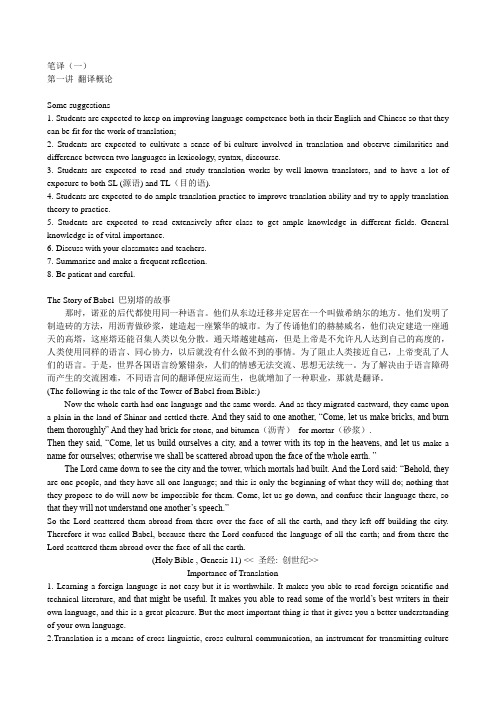
笔译(一)第一讲翻译概论Some suggestions1. Students are expected to keep on improving language competence both in their English and Chinese so that they can be fit for the work of translation;2. Students are expected to cultivate a sense of bi-culture involved in translation and observe similarities and difference between two languages in lexicology, syntax, discourse.3. Students are expected to read and study translation works by well-known translators, and to have a lot of exposure to both SL (源语) and TL(目的语).4. Students are expected to do ample translation practice to improve translation ability and try to apply translation theory to practice.5. Students are expected to read extensively after class to get ample knowledge in different fields. General knowledge is of vital importance.6. Discuss with your classmates and teachers.7. Summarize and make a frequent reflection.8. Be patient and careful.The Story of Babel 巴别塔的故事那时,诺亚的后代都使用同一种语言。
翻译讲义
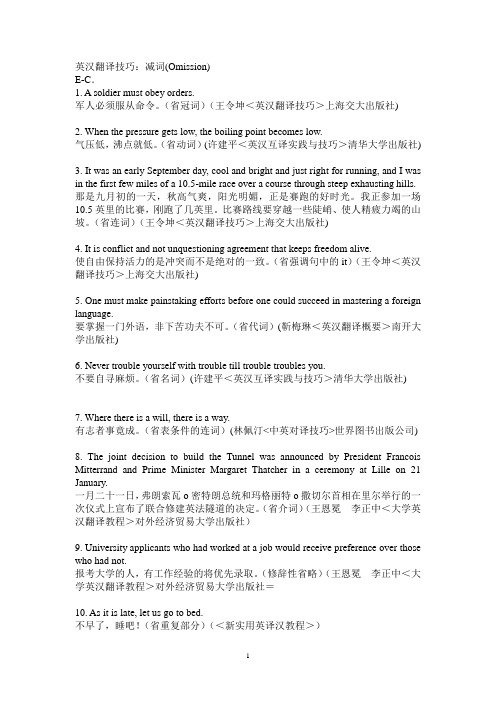
英汉翻译技巧:减词(Omission)E-C.1. A soldier must obey orders.军人必须服从命令。
(省冠词)(王令坤<英汉翻译技巧>上海交大出版社)2. When the pressure gets low, the boiling point becomes low.气压低,沸点就低。
(省动词)(许建平<英汉互译实践与技巧>清华大学出版社) 3. It was an early September day, cool and bright and just right for running, and I was in the first few miles of a 10.5-mile race over a course through steep exhausting hills.那是九月初的一天,秋高气爽,阳光明媚,正是赛跑的好时光。
我正参加一场10.5英里的比赛,刚跑了几英里。
比赛路线要穿越一些陡峭、使人精疲力竭的山坡。
(省连词)(王令坤<英汉翻译技巧>上海交大出版社)4. It is conflict and not unquestioning agreement that keeps freedom alive.使自由保持活力的是冲突而不是绝对的一致。
(省强调句中的it)(王令坤<英汉翻译技巧>上海交大出版社)5. One must make painstaking efforts before one could succeed in mastering a foreign language.要掌握一门外语,非下苦功夫不可。
(省代词)(靳梅琳<英汉翻译概要>南开大学出版社)6. Never trouble yourself with trouble till trouble troubles you.不要自寻麻烦。
(省名词)(许建平<英汉互译实践与技巧>清华大学出版社) 7. Where there is a will, there is a way.有志者事竟成。
文学翻译讲义
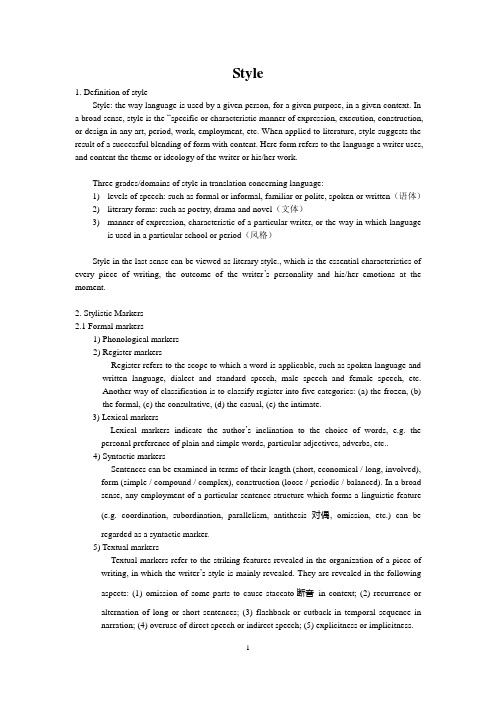
Style1. Definition of styleStyle: the way language is used by a given person, for a given purpose, in a given context. In a broad sense, style is the “specific or characteristic manner of expression, execution, construction, or design in any art, period, work, employment, etc. When applied to literature, style suggests the result of a successful blending of form with content. Here form refers to the language a writer uses, and content the theme or ideology of the writer or his/her work.Three grades/domains of style in translation concerning language:1)levels of speech: such as formal or informal, familiar or polite, spoken or written(语体)2)literary forms: such as poetry, drama and novel(文体)3)manner of expression, characteristic of a particular writer, or the way in which languageis used in a particular school or period(风格)Style in the last sense can be viewed as literary style., which is the essential characteristics of every piece of writing, the outcome of the writer‟s personality and his/her emotions at the moment.2. Stylistic Markers2.1 Formal markers1) Phonological markers2) Register markersRegister refers to the scope to which a word is applicable, such as spoken language and written language, dialect and standard speech, male speech and female speech, etc.Another way of classification is to classify register into five categories: (a) the frozen, (b) the formal, (c) the consultative, (d) the casual, (e) the intimate.3) Lexical markersLexical markers indicate the author‟s inclination to the choice of words, e.g. the personal preference of plain and simple words, particular adjectives, adverbs, etc..4) Syntactic markersSentences can be examined in terms of their length (short, economical / long, involved), form (simple / compound / complex), construction (loose / periodic / balanced). In a broad sense, any employment of a particular sentence structure which forms a linguistic feature(e.g. coordination, subordination, parallelism, antithesis对偶, omission, etc.) can beregarded as a syntactic marker.5) Textual markersTextual markers refer to the striking features revealed in the organization of a piece of writing, in which the writer‟s style is mainly revealed. They are revealed in the following aspects: (1) omission of some parts to cause staccato断音in context; (2) recurrence or alternation of long or short sentences; (3) flashback or cutback in temporal sequence in narration; (4) overuse of direct speech or indirect speech; (5) explicitness or implicitness.6) Markers of figures of speech(修辞格)e.g. Charles Dickens: irony and exaggeration2.2 Non-Formal Markers1) Ways of expressionEvery writer has his / her own way of expressing and processing what he / she writes about, even if they are of the same literary school.e.g. symbolic undertones象征性潜隐叙事法“Near the curb of the crowded sidewalk, pigeons were tossing around a bread crust that someone had dropped or thrown them. They couldn’t cope with it or let it be. These creatures filled me with both compassion for them and rage against their Creator. Where did they spend the nights in this severe weather? They must be cold and hungry. They might die this very night.”It seems that the writer is describing the phenomena in pigeons‟ world, but in fact he refers to the reality of human society. The symbolic meanings exist between and behind the lines, leaving much room for readers‟ exploration.2) Subject mattere.g. Hemingway‟s subject matter is always about death, violence, danger and the like. His preoccupation with individual courage, will and power is unique and characteristic of Hemingway style.3) Ideological Contents3. The difficulty in reproducing the original styleStyle is usually part of the original literary works‟ textual meaning; therefore harm will be done, to a great extent, to the textual meaning of the original, if the translator fails to pay enough attention to the style of the SLT in translation.Owing to the different natures of language, however, which may differ in word formation, syntactic structure, figure of speech, etc., there do exist some linguistic difficulties in stylistic transference. Those who believe style cannot be reproduced insist that style belongs to the category of linguistic form, not content. Form cannot be independent of the concrete mode of expression in the literary text, which has to be changed in the translating process, thus the style is changed accordingly. For example:1)此木为柴山山出,因火成烟夕夕多。
英语翻译讲义
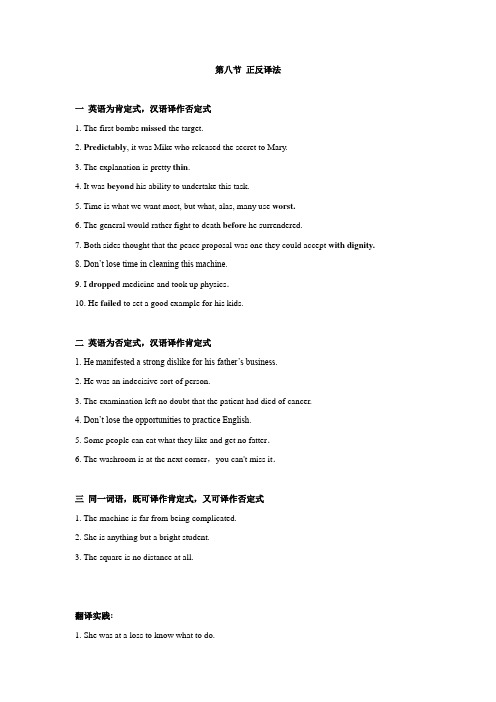
第八节正反译法一英语为肯定式,汉语译作否定式1. The first bombs missed the target.2. Predictably, it was Mike who released the secret to Mary.3. The explanation is pretty thin.4. It was beyon d his ability to undertake this task.5. Time is what we want most, but what, alas, many use worst.6. The general would rather fight to death before he surrendered.7. Both sides thought that the peace proposal was one they could accept with dignity.8. Don’t lose time in cleaning this machine.9. I dropped medicine and took up physics.10. He failed to set a good example for his kids.二英语为否定式,汉语译作肯定式1. He manifested a strong dislike for his father’s business.2. He was an indecisive sort of person.3. The examination left no doubt that the patient had died of cancer.4. Don’t lose the opportunities to practice English.5. Some people can eat what they like and get no fatter.6. The washroom is at the next corner,you can't miss it.三同一词语,既可译作肯定式,又可译作否定式1. The machine is far from being complicated.2. She is anything but a bright student.3. The square is no distance at all.翻译实践:1. She was at a loss to know what to do.2. His refusal was not final.3. I hate to say good-bye.4. My father will kill me when he finds out the truth.5. Many students went to class before they had prepared their lesson.6. In Greek myth, Helen’s beauty is beyond compare.7. The newspaper accounts are far from being true.8. He is the last man I want to see.9. I’ll do anything but that.10. Your temper is more than I can bear.11. “How are you?” “I couldn’t feel better.”12. There is no rule but has exceptions.13. You can’t be too careful.14. She is not a little interested in American Literature.15. He never met her afterwards without asking her the same question.16. She’s not stupi d, merely ignorant.17. Don’t lose time in catching up with us.18. Though they’ve held several meetings, the problem is still unsolved.第九节被动语态的译法一、翻译成汉语的主动句(一)原句中的主语在译文中仍做主语1. Nuclear power’s danger to health, safety and even life itself can b e summed up into one word : radiation..2. On their domestic stations events in the Middle East were dismissed briefly.3. Since this club was set up one month ago, more than 300 people have joined in it.(二)原文中的主语在译文中作宾语1. He said he was assured by the State Department that the U.S. is willing to normalize relationswith his country.2. The house has been sold out.3. It would be astonishing if that loss were not keenly felt.(三)翻译成带表语的主动句1 The decision to attack was not taken lightly.2 All scientific and technological achievements are founded on rational thinking, without which there would have been no science.(四)译为汉语的无主句1. The unpleasant noise must be immediately put an end to.2. Due care must be taken to ensure that the pulse signal itself shall show no irregularities and no interruptions.(五) 有些含有形式主语的英语句子,在英译汉时常改为主动句,可在汉译中加上主语“有人”、“人们”、“我们”、“大家”等,有的也可以不加。
翻译讲义
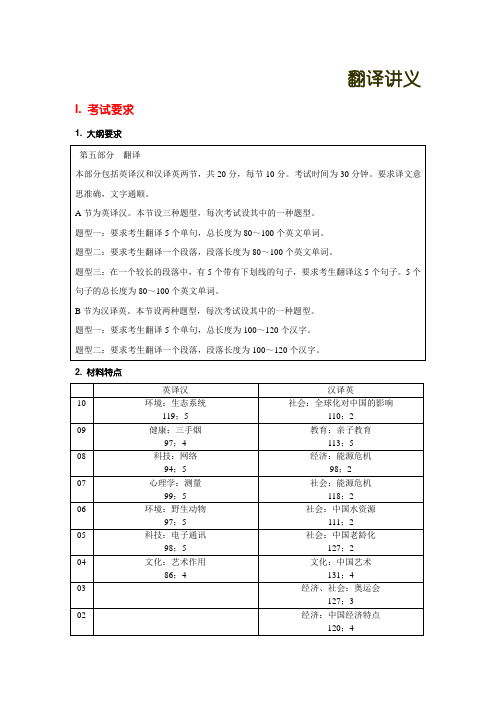
翻译讲义I. 考试要求1. 大纲要求2. 材料特点II. 英译汉1. 步骤:1) 找断点:介词、连词、标点符号五大逻辑关系:转折:conj. [Although though while even if, even though S V,] S V…. Prep. In spite of…. Despite…. Instead of….Adv. however, nevertheless, but因果:原因状语conj because since as in that now thatI was late [because there was a traffic jam]Prep because of…. Own to…. Due to….结果。
so that so + adj. / adv. that…..The traffic was so heavy [that I was late]目的so that in order thatSo as to do…. In order to do…条件if provided that S V…. supposing that…Given that …..unless = if notprep. Givenbut for but that 要不是并列和递进And A B and C adj. adj. and adj.V1 V2 and V3S V, SV and S V….总分:such n. as A B and Cn. such as A B and Ce.g.: such energy as sun, wind and tide.First second从句的连词定语从句That which whose who whom asWhere when why名词从句What how;how many how muchif whether…. 是否2) 找主谓S VTips: 1 be am is are was were2. 情态V + do….3. have has had + done4. do does did….3) 逻辑关系4) 组织语言e.g. 1. I || let bird <out of his cage>, you || see, this morning, and he ||’s disappeared.我让鸟出来他的笼子,你知道,今天早上,并且他不见了是这样的,我今天早上把小鸟放出笼子,他不见了Let sth./sb. <Adj./do/prep…>___________________e.g. 2. Although the object (of the annual performance review) || is to improve performance, it often || has the opposite result.尽管目标年度行为表现评估年度绩效评估为了提高行为表现,它经常有相反的结果尽管年度绩效评估的目标是为了改善工作表现,但是它经常适得其反___________________e.g. 3. It || is a very common belief that the problems (of the population explosion) || are caused mainly by poor people (living in poor countries) (who || do not know enough to limit their reproduction).It || is a very common belief that S V…人们|| 【普遍】认为People commonly believe that…Tips: n n 表功能MBA master of business administrationAdj. n.Doing + n.A swimming boy 现在分词表状态A swimming pool 动名词表功能n. (doing….) (who…..) 定语的翻译拆译法Do you know the lady (who lives in the next door)?住在隔壁的女士你认识那位女士吗,她就住在隔壁人们|| 【普遍】认为人口爆炸的问题主要是由生活在贫困国家的贫困人口造成的,他们对限制生育了解不足。
翻译讲义(19)

翻译知识与策略:conversionconversion from English nouns and adjectives into Chinese verbs and adverbs:1). All peace-loving people demand the complete prohibition and thorough destruction of nuclear weaspons. 一切爱好和平的人民都要求全面禁止核武器,彻底销毁核武器。
2). From the depths of its being, they are endeavoring to bring about a radical transformation of human life. 他们力图从根本上彻底改变人类生活。
3). He was a clever man; a pleasant companion, a careless student; with a great propensity for running into debt, and a partiality for the tavern. (V anity Fair) 他是个聪明人,谈吐非常风趣,可是学习上不肯用功,老是东挪西借,又喜欢上酒店喝酒。
4). Television is the transmission and reception of images of moving objects by radio waves. 用无线电波传送和接收活动物体图象的技术称为电视。
5). No violation of this principle can be tolerated. 违犯这一原则的行为是不允许的。
1.1.conversion from English adjectives into Chinese verbs:1). She is familiar with English grammar. 她熟悉英语语法。
翻译讲义(18)
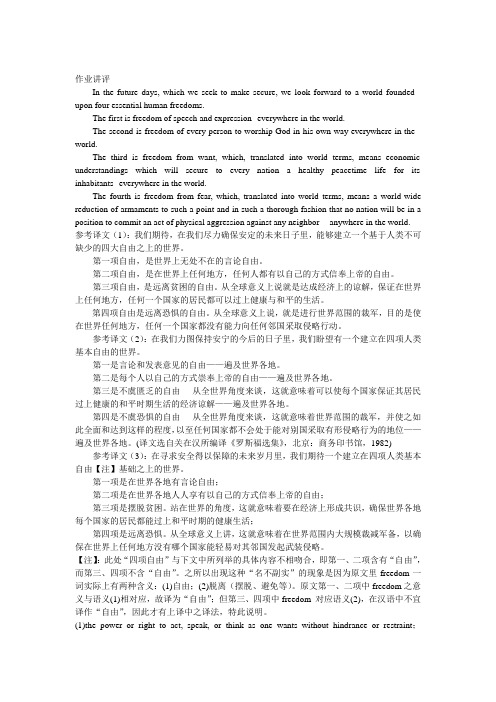
作业讲评In the future days, which we seek to make secure, we look forward to a world founded upon four essential human freedoms.The first is freedom of speech and expression--everywhere in the world.The second is freedom of every person to worship God in his own way everywhere in the world.The third is freedom from want, which, translated into world terms, means economic understandings which will secure to every nation a healthy peacetime life for its inhabitants--everywhere in the world.The fourth is freedom from fear, which, translated into world terms, means a world-wide reduction of armaments to such a point and in such a thorough fashion that no nation will be in a position to commit an act of physical aggression against any neighbor -- anywhere in the world.参考译文(1):我们期待,在我们尽力确保安定的未来日子里,能够建立一个基于人类不可缺少的四大自由之上的世界。
四级翻译讲义
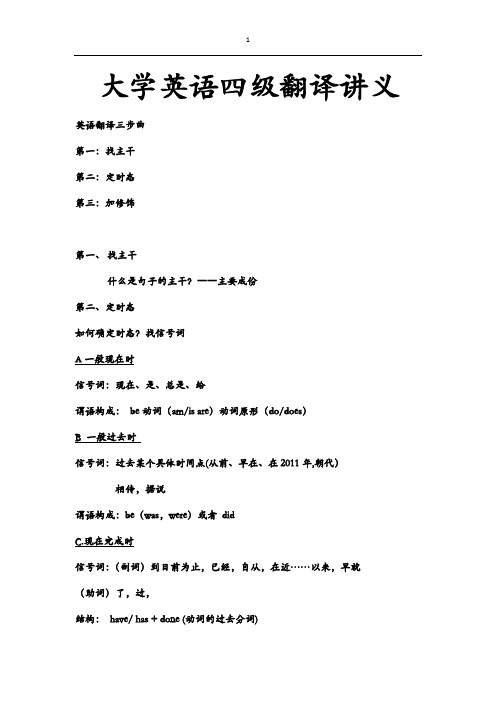
大学英语四级翻译讲义英语翻译三步曲第一:找主干第二:定时态第三:加修饰第一、找主干什么是句子的主干?――主要成份第二、定时态如何确定时态?找信号词A一般现在时信号词:现在、是、总是、给谓语构成:be动词(am/is are)动词原形(do/does)B 一般过去时信号词:过去某个具体时间点(从前、早在、在2011年,朝代)相传,据说谓语构成:be(was,were)或者didC.现在完成时信号词:(副词)到目前为止,已经,自从,在近……以来,早就(助词)了,过,结构:have/ has + done (动词的过去分词)表示完成时的时间状语标志D.一般将来时信号词:将来、会、可以…谓语构成:will (be going to)+doE 现在进行时信号词:正在、此时此刻、(助词)正……着谓语构成:be(am/is are)+doingF.情态动词结构:should/may/can/could/must等+do信号词:将,可能,也许时间状语一位帝王于五千年前发现了茶。
(1312四)An emperor found the tea five thousand years ago.在明清期间,茶馆遍布全国。
(1312四)During the Ming and Qing Dynasties, the tea houses were widespread all over the country.几个世纪以来,西湖一直以其秀美风景而闻名于世。
For centuries, the West Lake has been well-known for its beautiful scenery.地点状语“中国结”(Chinese Knot)在中文里意味着爱情,婚姻和团聚。
(1312四)Chinese Knot means love, marriage and reunion in Chinese.好的厨师总是努力在谷物、肉类和蔬菜之间取得平衡. (1312四)Good cooks always try to seek balance among grains, meat and vegetables.方式状语中国应进一步发展核能. (1406四)China should further develop the nuclear energy.食物对健康至关重要.(1312四)Food is crucially important to health.阅读对于中小学生尤为重要.(1406四)Reading is crucially important to primary and middle school students.目的状语为了,针对,以用to do 形式为驱厄运、迎好运,家家户户都会进行大扫除(样题)。
《英汉互译》教案与讲义
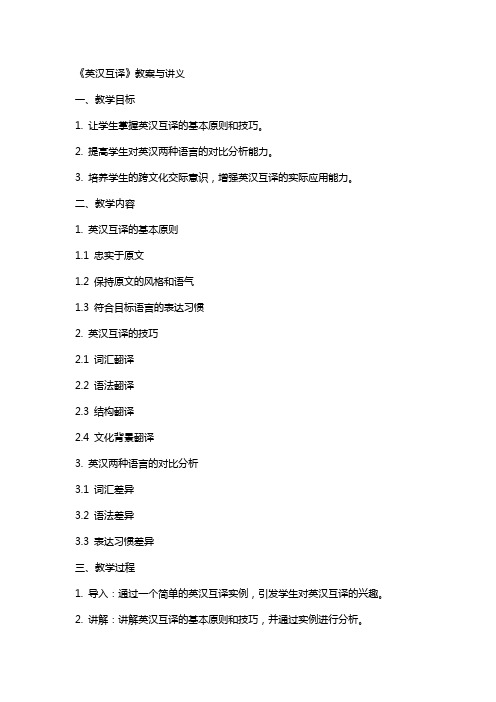
《英汉互译》教案与讲义一、教学目标1. 让学生掌握英汉互译的基本原则和技巧。
2. 提高学生对英汉两种语言的对比分析能力。
3. 培养学生的跨文化交际意识,增强英汉互译的实际应用能力。
二、教学内容1. 英汉互译的基本原则1.1 忠实于原文1.2 保持原文的风格和语气1.3 符合目标语言的表达习惯2. 英汉互译的技巧2.1 词汇翻译2.2 语法翻译2.3 结构翻译2.4 文化背景翻译3. 英汉两种语言的对比分析3.1 词汇差异3.2 语法差异3.3 表达习惯差异三、教学过程1. 导入:通过一个简单的英汉互译实例,引发学生对英汉互译的兴趣。
2. 讲解:讲解英汉互译的基本原则和技巧,并通过实例进行分析。
3. 对比分析:分析英汉两种语言的差异,并讲解如何在翻译过程中进行调整。
4. 练习:布置适量的英汉互译练习题,让学生进行实践操作。
四、教学方法1. 讲授法:讲解英汉互译的基本原则、技巧和语言差异。
2. 案例分析法:通过实例分析,让学生理解和掌握英汉互译的方法。
3. 练习法:让学生通过实际操作,提高英汉互译的能力。
五、教学评价1. 课堂参与度:观察学生在课堂上的积极参与情况和提问回答。
2. 练习完成情况:检查学生完成的英汉互译练习质量和数量。
3. 课后反馈:收集学生的课后反馈,了解他们对英汉互译的认识和困惑。
六、教学资源1. 教材:《英汉互译教程》2. 辅助材料:英汉互译案例集、多媒体课件3. 网络资源:相关英汉互译的在线资料和论坛七、教学环境1. 教室:宽敞、安静,有利于学生集中注意力2. 设备:投影仪、计算机、音响等教学设备八、教学进度安排1. 第一课时:介绍英汉互译的基本原则和技巧2. 第二课时:分析英汉两种语言的差异3. 第三课时:讲解英汉互译的实践操作4. 第四课时:布置练习题,进行课堂练习九、课后作业1. 复习本节课的内容,整理笔记2. 完成布置的英汉互译练习题3. 收集英汉互译相关的资料,进行自主学习十、教学反思2. 对学生的反馈进行整理,针对存在的问题进行调整教学策略3. 不断更新教学资源,提高自身教学水平,以更好地为学生服务重点和难点解析一、教学目标难点解析:跨文化交际意识的培养和实际应用能力的提升。
英汉翻译讲义-第五章PPT课件

03
翻译技巧
选词技巧
确定词义
在翻译过程中,需要确定每个 英文单词的准确含义,特别是
那些具有多重含义的单词。
选择合适的词汇
根据上下文和语境选择最合适 的词汇进行翻译,确保译文准 确传达原文的意思。
注意词义的褒贬色彩
在翻译时需要注意英文单词的 褒贬色彩,确保译文的情感色 彩与原文一致。
考虑文化因素
在选词时需要考虑文化因素, 选择符合目标语言文化的词汇 ,避免产生文化冲突或误解。
翻译的过程
理解阶段
在翻译过程中,首先需要对原文 进行深入理解,包括语义、语境、
文化背景等方面的理解。
表达阶段
在理解原文的基础上,译者需要运 用目标语言的表达方式将原文的意 义、情感和风格传达出来。
校对阶段
完成初步翻译后,译者需要进行校 对工作,检查译文中的错别字、语 法错误、表达不流畅等问题,并进 行修正。
英汉翻译讲义-第五章
目 录
• 第五章导言 • 翻译理论 • 翻译技巧 • 实践与案例分析 • 总结与思考
01
第五章导言
章节概述
01
介绍英汉翻译的基本原 则和技巧,包括直译、 意译、音译等。
02
探讨英汉两种语言在词 汇、语法、句法等方面 的差异。
03
分析英汉翻译中的常见 问题,如词义选择、句 子结构调整等。
下章预告
• 第六章:翻译中的修辞手法与风格处理
感谢您的观看
THANKS
根据不同的分类标准,翻译可以分为 多种类型,如文学翻译、科技翻译、 商务翻译等。
翻译的标准
01
02
03
忠实于原文
译文应忠实于原文,准确 传达原文的意义、情感和 风格,不得随意改动或曲 解。
英语翻译讲义
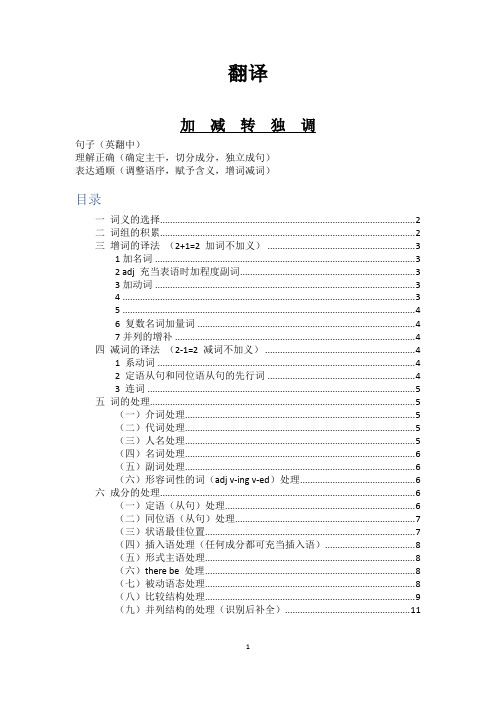
翻译加减转独调句子(英翻中)理解正确(确定主干,切分成分,独立成句)表达通顺(调整语序,赋予含义,增词减词)目录一词义的选择 (2)二词组的积累 (2)三增词的译法(2+1=2 加词不加义) (3)1加名词 (3)2 adj 充当表语时加程度副词 (3)3加动词 (3)4 (3)5 (4)6 复数名词加量词 (4)7并列的增补 (4)四减词的译法(2-1=2 减词不加义) (4)1 系动词 (4)2 定语从句和同位语从句的先行词 (4)3 连词 (5)五词的处理 (5)(一)介词处理 (5)(二)代词处理 (5)(三)人名处理 (5)(四)名词处理 (6)(五)副词处理 (6)(六)形容词性的词(adj v-ing v-ed)处理 (6)六成分的处理 (6)(一)定语(从句)处理 (6)(二)同位语(从句)处理 (7)(三)状语最佳位置 (7)(四)插入语处理(任何成分都可充当插入语) (8)(五)形式主语处理 (8)(六)there be 处理 (8)(七)被动语态处理 (8)(八)比较结构处理 (9)(九)并列结构的处理(识别后补全) (11)一词义的选择1.The intellectual equipment(储备,修养,结构)of an educated person2.The special preserve(专业知识)of lawyers3.His function(职业,责任,任务)is analogous to that of a judge4.He has not been charged(负责,主管,主抓)with the task5.He did not accept the charge(指责)made by some of his critics as well founded(是有根据的)6.His primary task is not to think about the moral code(规范)which governs(支配)his activity7.Developed(形成)the idea8. A unique and distinctly(非常)social science9.Children will play with dolls玩偶equipped with装有配有personality chip芯片10.This ability is built into us(与生俱来)in the same way好像that our body knowhow to heal a cut二词组的积累at the outset 一开始jump to the rescue 匆匆介入be obliged to do sth 被迫be obliged to sth 感谢on a daily basis 日常/每天take root 扎根、sort out 解决rests upon 取决于author of note有影响力的人piece together 汇编in…terms就…而言to kill two birds with one stone 异化(一石二鸟),归化(一箭双雕)to laugh off one’s head 归化(笑掉大牙)an uncharted continent 未知的大陆chart(航行)bound for 驶向virgin forest 原始森林in anticipation of 预计到=because ofthe competitive edge 竞争优势rip out 废除,撕毁,拆除joining the dots 了解mark sb out 使谁出类拔萃/与众不同fund-raising method 资金募集手段bring A to a close =bring to a close A (结束A)to the letter 严格地,不折不扣地pang of sth 一阵…f lash of sth …闪现a flash in the pan 归化(昙花一现)die down 减弱;平息next to 除开trade-off (名词)权衡,考虑may well 完全可能fronted by 由…领导liken A to B 把A比作Bstems from 源于end up(有时加with)最终成为,最后处于(往往是你不愿意的结果)no end=very muchi t upset me no end to hear they’d split up 听说他们要离婚,我感到非常不安keep your end up 不泄气,保持乐观make end meet 保持收支平衡at the end of the day 说到底we end ed up convinced …最后我们确信…bear the brunt of 首当其冲(brunt冲击;主要冲力)prepare A for B 让A做好应对B的准备deserving people 需要救济的人士三增词的译法(2+1=2 加词不加义)1加名词Studies serve for delight, for ornament and for ability读书可以使人从中获得乐趣,可以给人添加文采,可以使人增长才干。
翻译讲义4
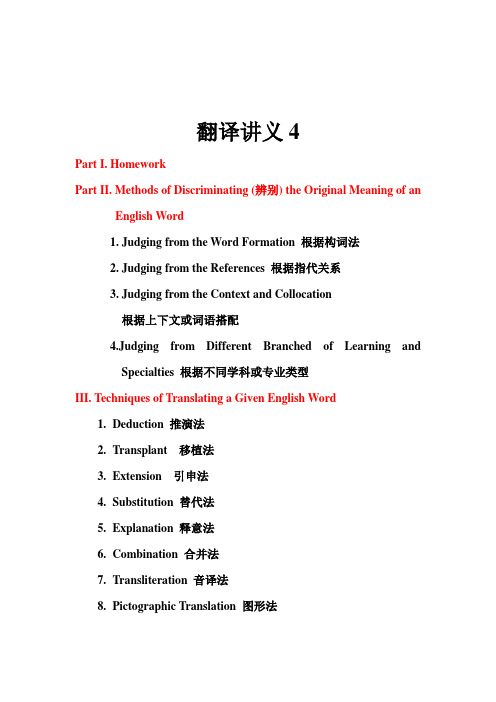
翻译讲义4Part I. HomeworkPart II. Methods of Discriminating (辨别) the Original Meaning of an English Word1. Judging from the Word Formation 根据构词法2. Judging from the References 根据指代关系3. Judging from the Context and Collocation根据上下文或词语搭配4.Judging from Different Branched of Learning andSpecialties 根据不同学科或专业类型III. Techniques of Translating a Given English Word1.Deduction 推演法2.Transplant 移植法3.Extension 引申法4.Substitution 替代法5.Explanation 释意法bination 合并法7.Transliteration 音译法8.Pictographic Translation 图形法Part I. HomeworkPlease translate the following terms, especially focus on the word “touch”:1.to touch sb. On the shoulder译文:轻轻按某人的肩膀拍某人的肩膀Re: with fingers or handsto put your hands or fingers onto sb. /sth.2.to touch one’s lips to the children’s forehead译文:轻吻小孩的前额Re: to move sth. 移动东西;to hit sb. 打某人(often in negative sentence) to move sth.; to hit or hurt sb.(常用于否定句) 移动,碰到; (打)人;使受伤害3.to touch glasses译文:碰杯Re: no space between(of two or more things, surface, etc.) to be or become so close together than that there is no space between(两个或以上的东西,表面等) 接触,触及4.to touch the high point in one’s career译文:达到某人的事业顶峰Re: reach level 达到水平to reach a particular level, etc.达到某一水平等5.to be touched to the quick译文:触及痛楚/痛处Re: affect sb./sth. 影响某人/某事to make sb. Feel upset or sympathetic 感动; 触动; 使同情quick n. often, the quick: the soft, sensitive flesh that is under the fingernails(指甲下的)活肉Idiom: cut sb. to the quick: to upset sb. very much by doing so saying sth. unkind.(恶意的言行) 深深伤害,把……伤到家6.hair touched with grey译文: 有点花白的头发Re: to affect or concern sb./sth. 影响, 与……有关7.to touch sb. to the heart译文: 触动某人的心弦8.Give your hair a touch of spring.译文: 给你的秀发(增)添一丝活力.给你的秀发(增)添一缕春色.给你的秀发春天的格调.给你的头发增添弹性.Re: touch of sth.(cn. often, sing.) a very small amount. 一点儿,少许spring: 1.春天, 春季;2.弹簧,弹力,弹性;3.泉水;4.活力,朝气;5.跳,跃;本句用的是引申意Part II. Methods of Discriminating (辨别) the Original Meaning of an English Word1.Judging from the Word Formation 根据构词法Since English words are prone (易于发生的) to various meanings, it is of vital importance for a given word. In order to discriminate the original meaning of an word ,it is necessary for us to have a knowledge of English lexicology and specially, a knowledge of word formation, such as compounding(复合词),derivation(派生词),affixation(缀合法), blending(拼缀词), acronym(首字母缩略词), clipping(缩略词), etc..中国的汉字,传说是仓颉造出来的,英语中没有类似的说法.但是,英语研究者也像中国学者把汉字分成象形\指事\会意\形声\专注\假借等六书一样,把英语单词的来源大致上分为五种:1). 基本词(base);2). 合成词(combining words);3). 缩略词(shortening words);4). 拼缀词(blending words);5). 转类词(shifting words).其中的基本词是那些在今天看来已经不可再分的词.这些词虽然在英语词汇中占少数,但是出现频率较高,是非专门记忆不可的.但是对于另外四类词来说,我们则可以借助构词法的一般知识,在阅读中撇掉字典,猜测它们的含义.首先我们来说一下缩略词.缩略词可分为两种:一种是对原来完整的词进行加工,缩略其中一部分字母,构成新词.如:phone=telephonecopter=helicopterauto=automobilead=advertisementflu=influenzafridge=refrigerator另外一种缩略词是首字母缩略词(acronyms),如:CIA=Central Intelligence AgencyCID=Criminal Investigate DepartmentICAC=Independent Commission Against CorruptionFBI=Federal Bureau of InvestigationFDI=Foreign Direct InvestmentNPC=National People’s CongressThe Standing Committee of National P eople’s CongressCCPCC=Chinese Communist Party’s Central CommitteeGDP=Gross Domestic ProductTOEFL=Test of English as a Foreign Language还有很多常见的:HSK,FIFA,UN,EU,NATO……拼缀词:就是对原来的两个词进行剪裁,取其中的一部分,连成一个新词如: Smog=smoke +fogMedicare =medical +care转类词:就是词汇不改变词形而转换了词类所构成的新词,如: 名词转动词: hand in one’s paper动词转名词: take a look以上的构词法在英语的构词中或者所占比例不大,或者需要有关的背景知识,所以在阅读中或者不足以引起障碍,或者就是产生非借助字典等客观手段不能解决的问题,主观的能动余地不大.在这几种构词法中最活跃也是最能引发人的主动性的要数合成词了.合成词包括派生词(derivation)和复合词(compounding word).所谓复合词是将两个或两个以上的词按照一定的次序排列构成的新词.如:合成名词: notebook, classroom合成形容词: life-long(终生的); wide-open(张大的,展开的)合成动词: underline(在下面划线) whitewash(粉刷)2.Judging from the References 根据指代关系In many cases the meaning of a word may be judged from the references. This is frequently shown in pronominal words(代词):1)third person pronouns; indefinite pronouns such as some, any,each, both; and definite pronouns such as much, many, few, little, etc. For example:He (father) sent John to the university and was eager to have him distinguish himself.他送约翰上大学, 巴望着能让儿子出类拔萃.2)demonstrative pronouns, such as this, that, these, anddemonstrative adverbs such as here, there, now, then, etc. For example:Health is above wealth, for this cannot give so much happiness as that.健康比财富更重要,因为财富不能像健康那样给人们那么多幸福.健康比财富更重要,因为后者不能像前者那样给人们那么多幸福.3)reference of comparison. For example:I hate blue shirt; white shirt suits me but gray is the mostpreferable.我讨厌穿蓝衬衫,喜欢穿白的,最喜欢穿灰的.3.Judging from the Context and Collocation 根据上下文或词语搭配4.Judging from Different Branched of Learning and Specialties根据不同学科或专业类型For example, the word “base”means “词根” in lexicology; “本金” in business; “底涂” in painting; “基线” in survey; “根据地”in military, and here are some more:The lathe(车床) should be set on a firm base.车床应安装在坚实的底座上.(机械)As we all know, a base reacts with an acid to form a salt.众所周知,碱与酸反应生成盐.(化学)A transistor has three electrodes, i.e., the base and the collector.晶体管有三个电极, 即发射极, 基极和集电极.(电子)Line AB is the base of the triangle ABC.AB是三角形ABC的底边.(数学)He is on the second base.他在二垒.(体育)The weary troops marched back to the base.疲惫不堪的士兵列队返回基地.III. Techniques of Translating a Given English Word1.Deduction 推演法Deduction is to deduce the original meaning in the light ofthe explanation of an English dictionary. This is a majormeans in E-C translation. For example:Challenge—to question the lawfulness or rightness of(something or somebody)对……表示怀疑,质疑; 对……提出异议2.Transplant 移植法That is to say a literal translation of the ingredients of a givenEnglish word.Microwave 微波Supermarket 超级市场Splashdown 溅落Data phone 数据送话机3.Extension 引申法This may be either from the specific to the general or fromthe concrete to the abstract, and vice versa.Bottleneck: 瓶颈—交通狭口—阻塞Brain trust: 脑托拉斯—智囊团Brain drain: 脑排干—人才外流—人才流失4.Substitution 替代法This technique is used to replace the word of the original expression with Chinese synonyms or idioms according to different situations.To kill sb. as an example 杀一儆百/杀鸡给猴看5.Explanation 释意法This technique is commonly used when there is no corresponding Chinese expression and all the above-mentioned techniques fail to make use. Mindlessness 思想上的混沌状态Togetherness 不分彼此的集体感Redshirt 美国大学中在体育方面有发展前途的学生A throwaway society 一个大手大脚,浪费成风的社会bination 合并法This technique is used to integrate two words of close meaning into one expression.So subtle and careful an observer 一个如此精细的观察者His mendacity and dishonesty他的狡诈A grim and tragic Christmas 一个惨淡的圣诞节The body and mind cramped by noxious work 有害工作造成的身心困顿7.Transliteration 音译法This technique is most frequently used in dealing with proper nouns (especially the names of people and places, trademarks, etc.). Besides, it is used in coinage when no existing Chinese expression is available.Wall Street 华尔街The Times 泰晤士报Pentium IV 奔腾Citroen 雪铁龙Hacker 黑客8.Pictographic Translation 图形法By this technique English words are translated according to their actual shapes.H-beam 工字梁U-steel槽钢X-brace 交叉支架O-ring 环形圈V-belt 三角皮带Y-curve 叉形曲线HomeworkPlease, translate the following sentences and pay much attention to your version of the word “develop”.1.His plane developed engine trouble only seven miles after takeoff.2.Modern aircraft are so heavy that the wings must develop a very largelift force in order to sustain the aircraft.3.Inspired by these ideas, in 1752 Franklin developed a particularlightning rod.4.A hypothesis is a specific statement developed by a scientist fromobservations.5.Until the domain theory of magnetism was developed,they did nothave much success.6.To develop the capabilities of the geophysical prospecting, the renewalof the techniques and equipment is the first thing to be considered. 7.Most of the money came from selling the secret of a new type ofpotato he had developed.8.As young John grew into manhood, he developed tuberculosis.9.We must develop all the natural substances in our country which canmake us rich.10.S everal attempts have been made through the years to develop thedeposit.11.I n developing a design, the engineer must apply his knowledge ofengineering and material science.Explanation of the Homework:Please, translate the following sentences and pay much attention to your version of the word “develop”.1.His plane developed engine trouble only seven miles after takeoff.译文:他的飞机刚飞了七英里,就发生了引擎故障.他的飞机刚飞了七英里,引擎就发生故障了.Re: developed v. Disease疾病/Problem问题to begin to have sth. such as a disease or a problem;患(病);出现(问题)to start to affect sb./sth.(疾病)开始侵袭;(问题)开始影响2.Modern aircraft are so heavy that the wings must develop a very largelift force in order to sustain the aircraft.译文:现在的飞机很重,机翼必须能够产生巨大的升力,才能保证飞行.现代飞机很重,所以机翼必须能够产生巨大的升力,才能保持/维持飞行.此句直译则译为:现在的飞机很重,机翼必须能够产生巨大的升力,以抵消飞机自身的重量.Re: aircraft n. (pl. aircraft) any vehicle that can fly and carry food, goods or passengers 飞机, 航空器develop n.to come to have gradually; acquire逐渐产生,培养出来;获得sustain v.(formal) to support a weight without breaking or falling支撑;承受住to provide enough of what sb./sth. needs in order to live or exist维持(生命,生存)to make continue for some time without becoming less使保持;使稳定;使持续3.Inspired by these ideas, in 1752 Franklin developed a practicallightning rod.译文:受这些想法的启发,1752年富兰克林研制出(一种)实用性避雷针. Re:inspire v. (usual, passive)to give sb. the idea for sth., especially sth. artistic or imaginative赋予灵感,激发想法(尤指艺术的或虚构的);启发;启示idea n. a plan, thought, or suggestion for a possible course of action计划;主意;念头;想法a picture in the mind; conception 思想; 概念developed v. New Idea新思想/Product新产品to think of or produce a new idea, product ect. and make it successful开发;研制practical adj. [褒]affective or convenient in actual use; suited to actual condition 实用的lightning n. 闪电rod n. 竿, 杆, 棒;(旧时打人用的)藤条,棍棒lightning rod 避雷针4.A hypothesis is a specific statement developed by a scientist fromobservations.译文:假设是科学家根据观察(所)得出的具体论断.Re: hypothesis n.假说,假设(有少量事实根据,但尚未被证实的)specific adj. particular; fixed, determined, or named具体的;特有的;突出的detailed and exact; clear in meaning or explanation明确的;确切的;精确的;详尽的developed v. New Idea新思想/Product新产品to think of or produce a new idea, product ect. And make itsuccessful 开发;研制5.Until the domain theory of magnetism was developed,they did nothave much success.译文:在磁的范畴这一理论提出之前,他们没有什么建树.Re: domain n. an area of activity, interest, or knowledge;(活动,兴趣,知识的)领域, 范围,……界magnetism n.磁力, 磁性developed v. New Idea新思想/Product新产品to think of or produce a new idea, product ect. and make itsuccessful 开发;研制6.To develop the capabilities of the geophysical prospecting, the renewalof the techniques and equipment is the first thing to be considered.译文:为了提高地球物理学方面的勘探能力,首先要考虑的是改进技术和更新设备.Re: developed v. Become Better变得更好to start to have a skill, ability, quality, etc. that becomes better andstronger;to become better and stronger加强;增强;发挥geophysical n. 地球物理学prospecting v.勘探,勘察(以寻找金,银,石油等矿藏)renewal---renew v. to replace (something old) with something new of the samekind更换;更新7.Most of the money came from selling the secret of a new type ofpotato he had developed.译文:他大部分的钱(收入)是出售自己培育的土豆新品种的秘方挣来的.Re: secret n. 秘诀,诀窍;秘密;神秘的事;奥秘;谜developed v. New Idea新思想/Product新产品to think of or produce a new idea, product ect. and make itsuccessful 开发;研制8.As young John grew into manhood, he developed tuberculosis.译文:约翰成年后患上了结核病.Re: manhood n. (男子的)成年期;成人;成年男子developed v. Disease疾病/Problem问题to begin to have sth. such as a disease or a problem;患(病);出现(问题)to start to affect sb./sth.(疾病)开始侵袭;(问题)开始影响tuberculosis n. 结核病9.We must develop all the natural substances in our country which canmake us rich.译文:我们必须开发能致富的各种国内自然资源.Re: substance n.a material; type of matter 物质natural substances:自然资源developed v. to bring out the full possibilities of (esp. land and natural substances.)开发(尤指土地,资源等)10.S everal attempts have been made through the years to develop thedeposit.译文:近几年,有过几次开采矿藏的尝试..Re: attempt n. an effort made to do something努力; 尝试; 企图developed v. to bring out the full possibilities of (esp. land and naturalsubstances.)开发(尤指土地,资源等)deposit n. 矿床;矿藏11.I n developing a design, the engineer must apply his knowledge ofengineering and material science.译文:进行设计时,这位工程师必须运用工程学和材料学方面的知识.. Re: developed v. New Idea新思想/Product新产品to think of or produce a new idea, product ect. and make it successful开发;研制apply v.运用engineering n. 工程学;工程师行业。
翻译讲义-高三英语二轮复习
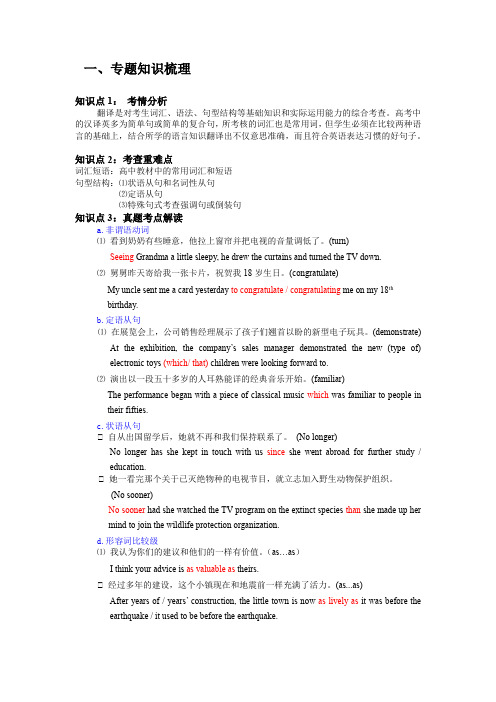
一、专题知识梳理知识点1:考情分析翻译是对考生词汇、语法、句型结构等基础知识和实际运用能力的综合考查。
高考中的汉译英多为简单句或简单的复合句,所考核的词汇也是常用词,但学生必须在比较两种语言的基础上,结合所学的语言知识翻译出不仅意思准确,而且符合英语表达习惯的好句子。
知识点2:考查重难点词汇短语:高中教材中的常用词汇和短语句型结构:⑴状语从句和名词性从句⑵定语从句⑶特殊句式考查强调句或倒装句知识点3:真题考点解读a.非谓语动词⑴看到奶奶有些睡意,他拉上窗帘并把电视的音量调低了。
(turn)Seeing Grandma a little sleepy, he drew the curtains and turned the TV down.⑵舅舅昨天寄给我一张卡片,祝贺我18岁生日。
(congratulate)My uncle sent me a card yesterday to congratulate / congratulating me on my 18thbirthday.b.定语从句⑴在展览会上,公司销售经理展示了孩子们翘首以盼的新型电子玩具。
(demonstrate)At the exhibition, the company’s sales manager demonstrated the new (type of)electronic toys (which/ that) children were looking forward to.⑵演出以一段五十多岁的人耳熟能详的经典音乐开始。
(familiar)The performance began with a piece of classical music which was familiar to people in their fifties.c.状语从句⑴ 自从出国留学后,她就不再和我们保持联系了。
(No longer)No longer has she kept in touch with us since she went abroad for further study /education.⑴ 她一看完那个关于已灭绝物种的电视节目,就立志加入野生动物保护组织。
《英汉互译》教案与讲义
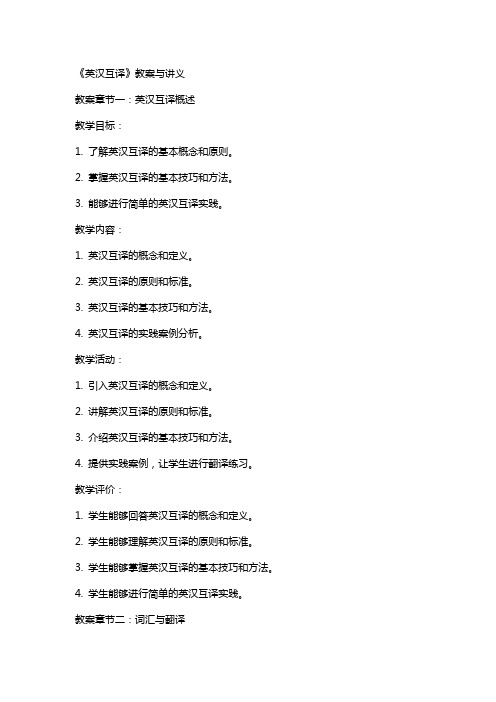
《英汉互译》教案与讲义教案章节一:英汉互译概述教学目标:1. 了解英汉互译的基本概念和原则。
2. 掌握英汉互译的基本技巧和方法。
3. 能够进行简单的英汉互译实践。
教学内容:1. 英汉互译的概念和定义。
2. 英汉互译的原则和标准。
3. 英汉互译的基本技巧和方法。
4. 英汉互译的实践案例分析。
教学活动:1. 引入英汉互译的概念和定义。
2. 讲解英汉互译的原则和标准。
3. 介绍英汉互译的基本技巧和方法。
4. 提供实践案例,让学生进行翻译练习。
教学评价:1. 学生能够回答英汉互译的概念和定义。
2. 学生能够理解英汉互译的原则和标准。
3. 学生能够掌握英汉互译的基本技巧和方法。
4. 学生能够进行简单的英汉互译实践。
教案章节二:词汇与翻译1. 了解词汇在英汉互译中的重要性。
2. 掌握英汉词汇的差异和转换方法。
3. 能够准确翻译词汇和短语。
教学内容:1. 词汇在英汉互译中的作用和重要性。
2. 英汉词汇的差异和转换方法。
3. 常见词汇和短语的翻译实例。
教学活动:1. 引入词汇在英汉互译中的作用和重要性。
2. 讲解英汉词汇的差异和转换方法。
3. 提供常见词汇和短语的翻译实例。
4. 让学生进行词汇翻译练习。
教学评价:1. 学生能够理解词汇在英汉互译中的重要性。
2. 学生能够掌握英汉词汇的差异和转换方法。
3. 学生能够准确翻译常见词汇和短语。
教案章节三:语法与翻译教学目标:1. 了解语法在英汉互译中的重要性。
2. 掌握英汉语法的差异和转换方法。
3. 能够正确翻译句子和段落。
1. 语法在英汉互译中的作用和重要性。
2. 英汉语法的差异和转换方法。
3. 常见语法错误的分析和纠正。
教学活动:1. 引入语法在英汉互译中的作用和重要性。
2. 讲解英汉语法的差异和转换方法。
3. 提供常见语法错误的分析和纠正。
4. 让学生进行句子和段落的翻译练习。
教学评价:1. 学生能够理解语法在英汉互译中的重要性。
2. 学生能够掌握英汉语法的差异和转换方法。
唐宋八大家翻译讲义

唐宋八大家散文翻译《原毁》1.古之君子,其责己也重以周,其待人也轻以约。
重以周,故不怠;轻以约,故人乐为善。
古时候的君子,他要求自己严格而周密,他对待别人宽容又简约。
严格而周密,所以不懈怠地进行道德修养;宽容又简约,所以人们都乐意做好事。
2.求其所以为舜者,责于己曰:“彼,人也,予,人也。
彼能是,而我乃不能是!”探究舜之所以成为舜的道理,对自己要求说:“他是个人,我也是个人,他能这样,我却不能这样!”3.举其一不计其十,究其旧,不图其新,恐恐然惟惧其人之有闻也。
指摘别人一个缺点,忽略其他众多的优点,追究人家的过去,不考虑人家的现在,小心谨慎地只生怕别人有了好名声。
4.夫是之谓不以众人待其身,而以圣人望于人,吾未见其尊己也。
这就叫做不用一般人的标准要求自身,却用圣人的标准期望别人,我看不出他是尊重自己的啊!5.是故事修而谤兴,德高而毁来。
因此,事情办好了,诽谤便随之产生;声望提高了,诋毁就接踵而来。
6.将有作于上者,得吾说而存之,其国家可几而理欤!居上位而将有所作为的人,听取我的说法记在心中,那国家差不多可以治理好了!《留侯论》7.天下有大勇者,卒然临之而不惊。
无故加之而不怒;此其所挟持者甚大,而其志甚远也。
天下真正具有豪杰气概的人,遇到突发的情形毫不惊慌,当无原因受到别人侮辱时,也不愤怒。
这是因为他们胸怀极大的抱负,志向非常高远。
8.观其所以微见其意者,皆圣贤相与警戒之义。
看那老人用以微微显露出自己用意的方式,都具有圣贤相互提醒告诫的意义。
9.夫持法太急者,其锋不可犯,而其势末可乘。
凡是执法过分严厉的君王,他的刀锋是不好硬碰的,而他的末余之势可以驾驭(连上句意思是:在锋芒之势上,是没有可乘之机的)。
10.千金之子,不死于盗贼。
何者?其身可爱,而盗贼之不足以死也。
富贵人家的子弟,是不肯死在盗贼手里的。
为什么呢?因为他们的生命宝贵,死在盗贼手里太不值得。
11.其君能下人,必能信用其民矣。
国君能够对人谦让,委屈自己,一定能得到自己老百姓的信任和效力。
英语翻译基础讲义

英语翻译基础讲义LIUYONGQUAN第一章翻译的基本原则1.Nature of Translation(翻译的性质)Translation is a science.Translation is an art.Translation is a craft.Translation is a skill.Translation is an operation.Translation is a language activity.Translation is communication2.Principles of Translation(翻译的原则)Three characters “信,达,雅”(faithfulness, expressiveness and elegance)———严复《天演论》Three characters “信,达,切”(faithfulness, expressiveness and closeness) ———刘重德《翻译十讲》Summary:忠实与通顺(1) Faithfulness of Translation (翻译的忠实)Strictly speaking, faithfulness is the generalization of the principles of translation. That’s to say, true translation demands that the translator be faithful to the content, language and style of the original at the same time.Eg. 1.War, pestilence and famine consumed one million people.战争,瘟疫和饥馑毁掉了一百万人。
该句译文从三个方面与原文都是一致的。
内容上,措辞完全对应;形式上,中英文都是陈述句,且语序相同。
大学英语四级翻译讲义

大学英语四级翻译讲义农历(the lunar calendar)起源于数千年前的中国,根据太阳和月亮的运行规律制定。
长期以来,农历在农业生产和人们日常生活中发挥着重要作用。
古人依据农历记录日期、安排农活,以便最有效地利用自然资源和气候条件,提高农作物的产量和质量。
中国的春节、中秋节等传统节日的日期都基于农历。
农历是中国传统文化的重要组成部分,当今依然广为使用。
The lunar calendar originated in China thousands of years ago and was formulated based on the movements of the sun and the moon.For a long time, the lunar calendar has played an important role in agricultural production and people’s daily lives.Ancient people used the lunar calendar to record dates and arrange farming activities to make the most efficient use of natural resources and climatic conditions,thereby improving the yield and quality of crops.Traditional Chinese festivals such as the Spring Festival and the Mid-Autumn Festival are all based on the lunar calendar.The lunar calendar is an important part of traditional Chinese culture and is still widely used today.四合院(siheyuan)是中国一种传统的住宅建筑,其特点是房屋建造在一个院子的四周,将院子合围在中间。
汉译英讲义
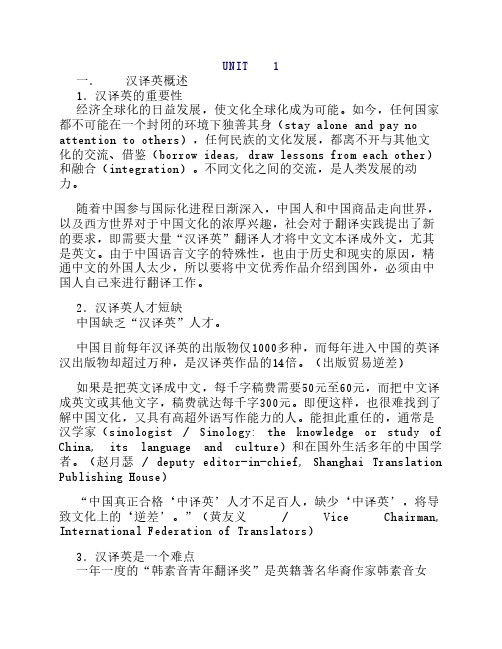
UNIT 1一. 汉译英概述1.汉译英的重要性经济全球化的日益发展,使文化全球化成为可能。
如今,任何国家都不可能在一个封闭的环境下独善其身(stay alone and pay no attention to others),任何民族的文化发展,都离不开与其他文化的交流、借鉴(borrow ideas, draw lessons from each other)和融合(integration)。
不同文化之间的交流,是人类发展的动力。
随着中国参与国际化进程日渐深入,中国人和中国商品走向世界,以及西方世界对于中国文化的浓厚兴趣,社会对于翻译实践提出了新的要求,即需要大量“汉译英”翻译人才将中文文本译成外文,尤其是英文。
由于中国语言文字的特殊性,也由于历史和现实的原因,精通中文的外国人太少,所以要将中文优秀作品介绍到国外,必须由中国人自己来进行翻译工作。
2.汉译英人才短缺中国缺乏“汉译英”人才。
中国目前每年汉译英的出版物仅1000多种,而每年进入中国的英译汉出版物却超过万种,是汉译英作品的14倍。
(出版贸易逆差)如果是把英文译成中文,每千字稿费需要50元至60元,而把中文译成英文或其他文字,稿费就达每千字300元。
即便这样,也很难找到了解中国文化,又具有高超外语写作能力的人。
能担此重任的,通常是汉学家(sinologist / Sinology: the knowledge or study of China, its language and culture)和在国外生活多年的中国学者。
(赵月瑟 / deputy editor-in-chief, Shanghai Translation Publishing House)“中国真正合格‘中译英’人才不足百人,缺少‘中译英’,将导致文化上的‘逆差’。
”(黄友义 / Vice Chairman, International Federation of Translators)3.汉译英是一个难点一年一度的“韩素音青年翻译奖”是英籍著名华裔作家韩素音女士,于1989年3月专门为中国青年人设立的,是目前我国最高的翻译竞赛奖。
- 1、下载文档前请自行甄别文档内容的完整性,平台不提供额外的编辑、内容补充、找答案等附加服务。
- 2、"仅部分预览"的文档,不可在线预览部分如存在完整性等问题,可反馈申请退款(可完整预览的文档不适用该条件!)。
- 3、如文档侵犯您的权益,请联系客服反馈,我们会尽快为您处理(人工客服工作时间:9:00-18:30)。
翻译专题讲解一、大学英语四级考试翻译题型概述:全国大学英语四级考试的最后一个题型是翻译,要求考生在5分钟内处理5个句子,占总成绩5%的比例。
这道题不是整句的中译英翻译,而是在英文句子中挖掉一部分,给出中文,要求考生将中文译成英文,使句子完整。
句子的长度一般在15个词左右,要求翻译的内容大约有3-8个单词。
如:It has been decided that the meeting___________(延期到下星期六).四级考试翻译(汉译英)试题难度相对较低,属于考生应该争取拿分的基础题。
命题没有在词汇方面设置很高的难度,对考生而言,选择正确的词汇和句型才是更大的挑战。
换言之,翻译试题更多考察的是考生对基本语法和基础词汇的掌握能力。
二、重点:虚拟语气、从句(定语从句、主语从句、状语从句)、比较级、分词、常用词组表达。
第一课时:(四级翻译)1虚拟语气:用来表示非真实的假设,或者用来表示命令、建议或说话人的主观愿望。
考生应能够根据所给的信息判断出需要使用虚拟语气的情况。
虚拟语气的表现形式多种多样,一般来说,四级考试常考的虚拟语气形式有如下四种。
1.11) The victim (本来会有机会活下来) if he had been taken to hospital in time.would have had a chance to survive2) If she had returned an hour earlier, Mary (就不会被大雨淋了)wouldn’t have been caught by the rain.1.2特殊动词在表示建议、要求、命令等的动词suggest、advise、propose、demand、require、insist、request、command、order等后的宾语从句中,谓语动词用should + 动词原形或是动词原形表示虚拟。
真题讲解:1)The professor required that (我们交研究报告) by Wednesday.We should hand in the research report.1.3 as if/as though, even if/even though在as if/as though、even if/even though等引导的表语从句或状语从句中表虚拟。
如果从句表示的动作发生在过去,用过去完成时表虚拟;指现在状况,则用一般过去时表虚拟;指将来状况则用过去将来时表虚拟。
真题讲解:1)Even if_________(他在这), she could not solve the problem.she were here1.4 由连接词in case, lest , for fear that引起的状语从句中,谓语动词要用虚拟形式,即should(might, would)+动词原形真题讲解:1)She put a blanket over the baby for fear that_______(他着凉).he should catch cold知识点测评1:翻译---虚拟语气1.The special committee recommended that _________________________________ (这项工程不应动工) until all the preparations have been made.答案:the project not be started考点:虚拟语气,动词recommend后的宾语从句中使用should 加动词原形的虚拟式,should 可以省略.2.The audience must have missed their musical performance or they________________________________________(给予高度评价).答案:would have spoken highly of it考点:1)虚拟语气,表示和过去事实相反时,主句用would havedone 结构;2)短语“给予…高度评价”,可译为speak highly of….3.He works very hard___________________________________.(好像永远不打算睡觉似的) 答案:as if he never intended to sleep.考点:本题考查的是as if的用法,as if 后面可以是真实情况,也可以是虚拟情况,如果是虚拟情况,对现在的虚拟要用一般过去时,对过去的虚拟,要用过去完成时。
4.I was really anxious about you. You______(你本不应该一句话不说就离开家)答案:shouldn't have left home without a word.考点:考查的是情态动词的虚拟,对过去情况的虚拟用过去完成时。
5. If we had caught the 10 o'clock train,we (午饭时间到那里).would have got there by lunch考点:同上2 定语从句:定语从句通常修饰名词或代词,对其进行限制、描述和说明。
受定语从句修饰的词语叫先行词,引导定语从句的词语叫关系词。
关系词按其性质又分关系代词和关系副词。
关系代词主要有that, who, whose, which等,它们在定语从句可用作主语、宾语或定语;关系副词主要有when, where 和why,它们在定语从句中均用作状语。
关系词不仅引导定语从句,同时还在定语从句充当一定的句子成分。
that 与which的用法区别:两者都可指物,有时可互换。
其区别主要在于:(1) 引导非限制性定语从句时,通常只用which:He drove too fast, which was dangerous. 他开车很快,这是很危险的。
(2) 直接放在介词后作宾语时,通常只用which:The tool with which he is working is called a hammer. 他干活用的那个工具叫做锤子。
(3) 当先行词是none, all, everything, anything等不定代词或受其修饰时,通常用that:All [Everything] that can be done must be done. 凡能做的事都必须做。
(4) 当先行词受the very, the only, the same 等修饰时,通常用that:This is the only example that I know. 我知道的例子只有这一个。
(5) 当先行词有形容词最高级或序数词等修饰时,通常用that:This is the best dictionary that I’ve ever used. 这是我用过的最好的词典。
(6) 当先行词是一个既指人又指物的并列词组时,通常用that:They talked about the persons and things that most impressed them. 他们谈论了使他们印象最深的人和事。
真题讲解:1) The prevention and treatment of AIDS is (我们可以合作的领域)The field in which we can cooperate2. Medical researches are painfully aware that there are many problems_________ (他们至今还没有答案) (08.12)to which they still have no answers知识点测评2:翻译---定语从句1. What he objects to is the bureaucracy, ____.(这种情况正在不断滋长)答案:which is on the increase.考点:本题考查非限制性定于从句which 指代前句话的用法,考生不易想到。
2. We felt very disappointed after the show,______.(因为很多应该参加演出的名演员没有来)答案:as many famous stars who should have appeared did not come.考点:用关系代词who引导定语从句;在英语中表示过去应该做而实际上没有做的事,要用“should + have +过去分词”的句式。
3 主语从句:作句子主语的从句叫主语从句。
主语从句通常由从属连词that,whether,if 和连接代词what,who,which,whatever,whoever以及连接副词how,when,where,why 等词引导。
that在句中无词义,只起连接作用;连接代词和连接副词在句中既保留自己的疑问含义、又起连接作用,在从句中充当从句的成分。
例如:What he wants to tell us is not clear. 他要跟我们说什么,还不清楚。
Who will win the match is still unknown. 谁能赢得这场比赛还不得而知。
It is known to us how he became a writer.我们都知道他是如何成为一名作家的。
Where the English evening will be held has not been announced. 英语晚会将在哪里举行,还没有宣布。
真题讲解:1)(很多人所没有意识到的)is that Simon is a lover of sports, and football in particular.What people don’t realize2)(大多数父母所关心的)is providing the best education possibility for their children.What most parents are concerned about4 状语从句1.1 地点状语从句(adverbial clause of place) where, wherevere.g. You should have put the book where you found it. 你本来应该把书放回原来的地方.e.g. We will go wherever the motherland needs us most.我们要到祖国最需要的地方去1.2 原因状语从句,(adverbial clause of cause) because ,as, since常用的引导连词有because,as和since,三者的区别是:在回答问题的时候,使用because;对于显而易见的原因,常用as或since;as和since的从句常放在主句之前,而because的从句常放在主句之后。
